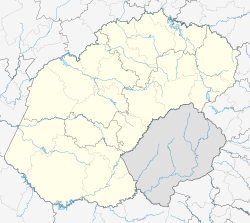Boshof | |
|---|---|
 The Dutch Reformed Church in Boshof, c. 1917 | |
| Coordinates: 28°33′S25°14′E / 28.550°S 25.233°E | |
| Country | South Africa |
| Province | Free State |
| District | Lejweleputswa |
| Municipality | Tokologo |
| Established | 1856 [1] |
| Area | |
• Total | 91.7 km2 (35.4 sq mi) |
| Population (2011) [2] | |
• Total | 8,509 |
| • Density | 92.8/km2 (240/sq mi) |
| Racial makeup (2011) | |
| • Black African | 78.5% |
| • Coloured | 10.5% |
| • Indian/Asian | 0.4% |
| • White | 10.1% |
| • Other | 0.5% |
| First languages (2011) | |
| • Tswana | 57.9% |
| • Afrikaans | 28.7% |
| • Sotho | 4.4% |
| • Xhosa | 3.8% |
| • Other | 5.1% |
| Time zone | UTC+2 (SAST) |
| Postal code (street) | 8340 |
| PO box | 8340 |
| Area code | 053 |
Boshof is a small rural farming town located in the western part of the Free State province, South Africa.
Contents
- History
- Early Settlement
- Etymology
- Early Development
- Second Anglo-Boer War
- 20th Century and Modern Era
- References
The town is approximately 55 km north-east of Kimberley along the R64 road. It serves as the administrative centre of the Tokologo Local Municipality within the Lejweleputswa District and is known for mixed farming activities, including livestock and crop production.


